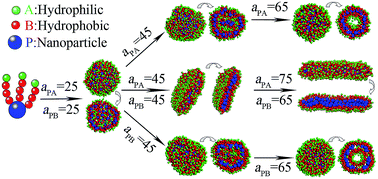Controlling the localization of nanoparticles in assemblies of amphiphilic diblock copolymers†
Abstract
We performed a dissipative particle dynamics (DPD) approach to study the self-assembly of AB diblock copolymer tethered nanoparticles (P) in dilute solutions. Different morphological aggregates, including spherical micelles, vesicles, disk-like micelles and rod-like micelles, were found by varying the interaction between block copolymers and nanoparticles. Most importantly, the nanoparticles can selectively localize in the different domains within the aggregates. When the repulsive interaction between block copolymers and nanoparticles aPA = aPB = 25, the nanoparticles are evenly distributed within the spherical micelles. While aPA or aPB increases, the nanoparticles gradually aggregate and separate from copolymers and then localize in the central portion of vesicular wall or disk-like and rod-like micelles. The degree of stretching of the tethered copolymer chains gradually grows with the increase of aPA or aPB, while the degree of stretching of solvophobic block B decreases when the morphologies change from spherical to disk-like micelles and further to rod-like micelles. This work illustrates that tuning the miscibility of copolymers and nanoparticles could be used to project the selective localization of nanoparticles within the aggregates self-assembled by diblock copolymer tethered nanoparticles in dilute solutions.


 Please wait while we load your content...
Please wait while we load your content...